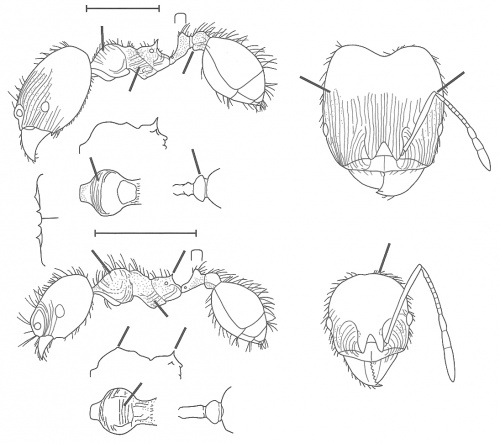Pheidole gaigei
| Pheidole gaigei | |
|---|---|

| |
| Scientific classification | |
| Kingdom: | Animalia |
| Phylum: | Arthropoda |
| Class: | Insecta |
| Order: | Hymenoptera |
| Family: | Formicidae |
| Subfamily: | Myrmicinae |
| Tribe: | Attini |
| Genus: | Pheidole |
| Species: | P. gaigei |
| Binomial name | |
| Pheidole gaigei Forel, 1914 | |
Nothing is known about the biology of gaigei.
Identification
See the description in the nomenclature section.
Keys including this Species
Distribution
Only known from the type locality.
Latitudinal Distribution Pattern
Latitudinal Range: 5.821667° to 5.821667°.
| North Temperate |
North Subtropical |
Tropical | South Subtropical |
South Temperate |
- Source: AntMaps
Distribution based on Regional Taxon Lists
Neotropical Region: Colombia (type locality).
Distribution based on AntMaps
Distribution based on AntWeb specimens
Check data from AntWeb
Countries Occupied
| Number of countries occupied by this species based on AntWiki Regional Taxon Lists. In general, fewer countries occupied indicates a narrower range, while more countries indicates a more widespread species. |

|
Estimated Abundance
| Relative abundance based on number of AntMaps records per species (this species within the purple bar). Fewer records (to the left) indicates a less abundant/encountered species while more records (to the right) indicates more abundant/encountered species. |

|
Biology
Castes
Nomenclature
The following information is derived from Barry Bolton's Online Catalogue of the Ants of the World.
- gaigei. Pheidole gaigei Forel, 1914c: 616 (s.w.) COLOMBIA. See also: Wilson, 2003: 692.
Unless otherwise noted the text for the remainder of this section is reported from the publication that includes the original description.
Description
From Wilson (2003): DIAGNOSIS A member of the tristis group, similar to Pheidole balzani, Pheidole godmani, Pheidole grandinodus, Pheidole huilana, Pheidole obrima, and, less so, to species listed with them, distinguished as follows.
Major: postpetiole from above bell-shaped, 2X broader than petiole; postpetiole with prominent ventral, forward-projecting subangular process; anterior third of pronotal dorsum and all of mesopleuron carinulate; carinulae on dorsal surface of head reach midway between eye and occipital border.
Minor: occiput very broad, lacking nuchal collar; propodeal spines reduced to denticles; margins all around of pronotal dorsum, as well as lower half of mesopleuron, carinulate.
MEASUREMENTS (mm) Syntype major: HW 1.28, HL 1.38, SL 0.72, EL 0.08, PW 0.62. Syntype minor: HW 0.64, HL 0.72, SL 0.66, EL 0.12, PW 0.44.
COLOR Major: concolorous light reddish yellow.
Minor: concolorous brownish yellow.
Figure. Upper: syntype, major. Lower: syntype, minor. Scale bars = 1 mm.
Type Material
COLOMBIA: Mt. San Lorenzo, Sierra Nevada de Santa Marta, 1700 m. Musee d'Histoire Naturelle Genève and Museum of Comparative Zoology - as reported in Wilson (2003)
Etymology
Eponymous. (Wilson 2003)
References
- Forel, A. 1914c. Einige amerikanische Ameisen. Dtsch. Entomol. Z. 1914: 615-620 (page 616, soldier, worker described)
- Wilson, E. O. 2003. Pheidole in the New World: A dominant, hyperdiverse ant genus. Harvard University Press, Cambridge, MA. (page 692, fig. major, minor described)
References based on Global Ant Biodiversity Informatics
- Wilson E. O. 2003. Pheidole in the New World. A dominant, hyperdiverse ant genus. Cambridge, Mass.: Harvard University Press, [ix] + 794 pp.



